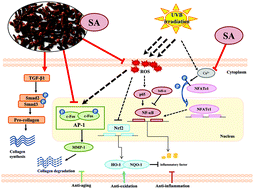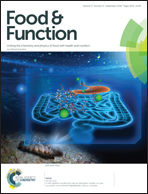Clove attenuates UVB-induced photodamage and repairs skin barrier function in hairless mice
Abstract
Syzygium aromaticum L., commonly named clove, is widely used in the food industry due to its antioxidant and antibacterial capabilities. However, little information is available regarding its role in resisting skin photoaging. This study investigated 50% ethanol extract of Syzygium aromaticum L. (SA) and eugenol (EO) for anti-aging effects in UVB-irradiated normal human dermal fibroblasts (NHDFs) and hairless mice. In vitro, SA and EO suppressed matrix metalloproteinase-1, 3 (MMP-1 and MMP-3) secretion as well as the activator protein 1 (AP-1) phosphorylation. SA and EO also activated nuclear erythroid 2-related factor/antioxidant-response element (Nrf2/ARE) signaling which improves the antioxidant activity and inhibited nuclear factor-κB (NF-κB) and interleukin-6 (IL-6) expression, pro-inflammatory factors. Furthermore, SA and EO suppressed the nuclear factor of activated T cells c1 (NFATc1) which is a known activator of MMPs, cooperator transforming growth factor beta (TGF-β) and NF-κB in Ca2+/calcineurin-regulated transcription. In vivo, SA significantly improved the levels of procollagen type I and elastin through TGF/Smad signaling. The histopathological studies found that SA reduced wrinkles. SA also increased filament aggregating protein (filaggrin), which repairs the skin barrier function and improved the skin's hydration. Altogether, SA effectively ameliorated UVB-induced photoaging. It is expected to become a promising natural product.



 Please wait while we load your content...
Please wait while we load your content...